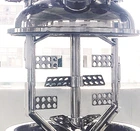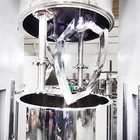Integrating development, manufacturing and sales, as a first-level mixer emulsifier factory.
Should You Invest in a Full Production Line?
Investing in a full production line is a major step in food and process manufacturing. It’s a decision that touches on cost, output potential, process optimization, and long-term business goals. For many, the move from individual machines to a fully integrated setup is both promising and daunting.
So, is it the right choice for your business?
What Is a Full Production Line?
A full production line includes all the machinery needed to process, fill, seal, label, and prepare your products for shipment — all working in sync. This usually involves:
- Mixing & Processing Units (e.g., emulsifiers, batch cookers, mixers).
- Filling Machines (for bottles, jars, tubes, or pouches).
- Capping/Sealing Equipment.
- Labeling & Coding Systems.
- Conveyors & Automation.
- CIP (Clean-in-Place) Systems for internal sanitation.
(See our article "Never Overlook Compliance & Safety" for more on CIP systems.)
This setup creates a smooth, end-to-end operation — from raw ingredients to retail-ready products.
Why Consider It?
A fully integrated line brings important gains:
- Speed: Faster production and output
- Consistency: Precise filling, mixing, and packaging
- Hygiene: CIP and closed-loop systems reduce contamination
- Efficiency: Fewer bottlenecks, reduced waste
- Traceability: Batch and ingredient tracking for compliance
This matters most for complex or delicate products — such as emulsified sauces, creams, or other formulations where even small process variations impact the end result.
The Cost Picture: More Than Machinery
Upfront costs can be high. You’ll need to budget for:
- Initial Investment: Equipment and automation infrastructure
- Customization: Line configuration to your product specs
- Training: Operator education and system integration
- Utilities & Space: More room, more power, more water
- Ongoing Maintenance: Preventive service and repairs
Still, don’t forget the hidden costs of fragmented operations: wasted time, inconsistent batches, manual labor, and compliance risk. A full line often offsets these over time.
How It Changes Your Workflow
With full automation, your team’s role shifts:
- Fewer manual interventions
- Higher need for trained operators
- Digital interfaces and process monitoring
It’s not just a technology purchase — it’s a rethinking of how you run your production.
Return on Investment: Look Beyond the Price Tag
Ask yourself:
- Does this setup let us scale faster?
- Can we reduce labor or reallocate staff?
- Are we reducing waste and downtime?
- Can we meet hygiene and export standards more easily?
If the answer is yes, a full line may start saving you money — and adding value — faster than expected.
Don’t Overlook Flexibility
Some fear that a complete line is too rigid. But many systems today offer:
- Modular Design: Add or remove machines as needed
- Quick Changeovers: Adapt between SKUs or formats
Still, if your product range is very diverse or seasonal, flexibility must be a key factor in your planning.
When to Invest
A full line may be the right step if:
- Your demand is growing or stable
- You want to increase volume without losing control
- You’re aiming to meet export or GMP requirements
- Manual operations are slowing you down
When to Wait
Hold off if:
- You’re still in testing or product development
- Production is limited to short runs or prototypes
- Agility and small-batch flexibility matter more
- Budget is limited and the ROI is unclear
Final Thoughts
A full production line isn’t just about machines — it’s a strategic move toward scalable, repeatable, and compliant manufacturing. If your operations are already focusing on safety, hygiene, and consistency, then full-line integration may be the natural next step.
Need more insight? Check our guide "Top 5 Mistakes to Avoid When Buying a Filling Machine" — the principles apply to many types of process equipment.
Questions or project in mind? Reach out to our experts. We’re here to help tailor the solution to your product and production goals.














































































































